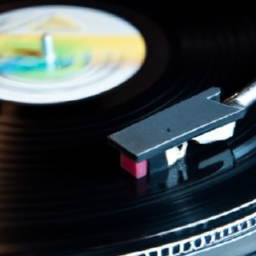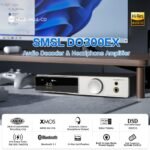If you’ve ever wondered about the buzz surrounding DSD audio, it’s time to separate fact from fiction. In this article, we’ll debunk common myths and help you understand the reality of DSD audio. From its origins to its technical aspects, we’ll explore why DSD audio has gained popularity in the audiophile community. So, grab your headphones and get ready to uncover the truth about DSD audio.
Understanding DSD Audio
Definition of DSD Audio
DSD (Direct Stream Digital) audio is a digital format that Sony and Philips developed in the late 1990s. It is known for its high-resolution audio quality and is often used in professional recording studios and by audiophiles who demand the highest fidelity. The format uses a different digital audio approach than the more popular PCM (Pulse Code Modulation) format. Instead of representing audio as a series of samples, DSD describes it as a stream of single-bit values at an extremely high sampling rate.
The Process of DSD Audio Creation
The creation of DSD audio involves the conversion of analog audio signals into digital form using a specialized analog-to-digital converter (ADC). This conversion process captures the audio waveform with a very high level of precision and detail. Once in the digital domain, the audio is further processed and edited before being converted into analog form for playback. The DSD format allows for finer adjustments and editing possibilities, providing the opportunity to achieve the highest level of audio fidelity.
DSD versus PCM: A Comparison
DSD and PCM are two different approaches to digital audio, and both have strengths and weaknesses. PCM widely supports various applications, including CD and streaming platforms. PCM audio is based on a series of numeric samples taken at regular intervals, and the bit depth and sample rate determine the level of detail and frequency response. On the other hand, DSD uses a different approach, with a much higher sampling rate but only a single bit depth. This unique characteristic allows DSD to capture and reproduce audio with incredible accuracy and transparency.
Myths Surrounding DSD Audio
Number of Channels in DSD Audio
There is a common misconception that DSD audio can only support a limited number of channels. This is not true. The format does not inherently limit the number of channels in DSD audio. DSD supports both mono and stereo configurations, just like PCM. DSD can accommodate up to six channels for multichannel applications, making it suitable for surround sound setups.
The Quality of DSD Audio is Supreme
While it is true that DSD audio can deliver exceptional audio quality, it does not necessarily mean that it is inherently superior to PCM. The audio quality ultimately depends on various factors, including the source material, recording techniques, and the equipment used for playback. DSD and PCM formats have strengths and can provide exceptional audio quality when implemented correctly.
DSD Audio Files are not Compatible with Ordinary Audio Equipment
Another common myth surrounding DSD audio is that it is incompatible with ordinary audio equipment. This is not entirely accurate. While DSD audio requires specialized playback equipment that supports the format, various solutions are available to enjoy DSD audio on regular audio setups. Many modern audio players and digital-to-analog converters (DACs) support DSD playback, and software solutions exist to convert DSD files to PCM, enabling compatibility with a broader range of equipment.
The reality of DSD Audio Quality
Decoding the Quality of DSD Audio
DSD audio quality can be exceptional, thanks to its unique approach to digital audio. The high sampling rate of DSD allows for capturing and reproducing audio with incredible precision and detail. The single-bit depth used in DSD may seem limited compared to the higher bit depths used in PCM, but it is important to note that DSD’s high sampling rate compensates for that. The result is a smooth, detailed, natural sound reproduction that many audiophiles find highly pleasing.
Role of Sampling Frequencies in Quality
The sampling frequency, or the number of samples taken per second, plays a crucial role in determining the quality of DSD audio. DSD audio typically uses a sampling frequency of 2.8 MHz or higher, significantly higher than the standard CD audio sampling rate of 44.1 kHz. This higher sampling frequency allows for a much broader frequency response and better resolution, more accurately representing the original audio signal.
DSD vs PCM: Which is Better in Quality?
The debate over which format, DSD or PCM, is better regarding audio quality is subjective and often depends on personal preferences. Both forms have their advantages and offer exceptional audio quality when appropriately implemented. Some enthusiasts argue that DSD provides a more natural and analog-like sound, while others prefer PCM’s flexibility and broader compatibility. Ultimately, the choice between DSD and PCM comes down to individual taste and the specific audio system requirements.
The Technicalities of DSD Audio
Understanding Bit Depth in DSD
The bit depth in DSD audio refers to the number of bits representing the audio signal. Unlike PCM, which typically uses multiple bits per sample, DSD utilizes a single bit. This might seem like a limitation, but the high sampling rate of DSD compensates for it by capturing a more detailed representation of the audio waveform. The single-bit depth of DSD results in a more efficient encoding process and allows for a more accurate reproduction of the original analog audio.
Role of Sampling Rate in DSD
The sampling rate in DSD audio determines the number of samples taken per second. DSD audio typically uses a sampling rate of 2.8 MHz, 5.6 MHz, or 11.2 MHz. The higher the sampling rate, the more samples are taken, resulting in a more accurate representation of the original audio signal. The high sampling rate of DSD allows for capturing even the most minor details and nuances in the audio, resulting in a more realistic and immersive listening experience.
Concept of DSD Noise Shaping
DSD audio employs noise shaping to achieve its high-quality sound reproduction. Noise shaping is a process that reduces the inherent noise floor in digital audio by shifting it to higher frequencies, where it is less perceptible. This technique allows DSD to achieve a more excellent dynamic range and improved signal-to-noise ratio, resulting in a cleaner and more transparent sound. The careful implementation of noise shaping is crucial in maintaining the high-quality characteristics of DSD audio recordings.
Demystifying the Channel Myth in DSD Audio
The Mono and Stereo Myth
Contrary to popular belief, DSD audio is not limited to mono or stereo configurations. DSD supports both mono and stereo recordings, just like PCM. Mono recordings use a single audio channel, while stereo recordings utilize two channels to create a sense of spatial audio. DSD audio can provide a truly immersive listening experience in mono and stereo configurations, capturing the depth and nuances of the original sound source.
DSD Audio Multichannel Configurations
DSD is not limited to mono or stereo; it can also be used for multichannel configurations. DSD supports up to six channels, making it ideal for surround sound applications. Multichannel DSD recordings can provide a realistic and immersive audio experience, enveloping the listener in a 360-degree audio environment. This makes DSD a preferred format for home theater systems and music recordings for multichannel playback.
Influence of Channels on Audio Quality
The number of channels in DSD audio does not directly impact the overall audio quality. The audio quality depends on various factors, such as the recording techniques, the mixing/mastering process, and the capabilities of the playback equipment. Whether a mono, stereo, or multichannel DSD recording, the audio quality will be determined by how well the recording and playback processes are executed. Each channel in DSD contributes to the overall audio presentation, offering a more immersive and detailed listening experience.
Debunking Compatibility Myths of DSD Audio
DSD Audio Player Requirements
Specialized DSD audio players or digital-to-analog converters (DACs) are required to enjoy DSD audio fully. These players or DACs must support DSD playback and be capable of decoding the DSD audio files. Many high-end audio players and DACs cater to DSD enthusiasts, providing the necessary hardware and firmware support for seamless DSD playback. However, it is essential to check the specifications and capabilities of any audio equipment to ensure its compatibility with DSD audio files.
Compatibility of DSD with Various Audio Setups
While DSD audio requires dedicated players or DACs for playback, software solutions exist to allow compatibility with ordinary audio setups. Some media players and audio software platforms offer plugins or built-in functionality to convert DSD files to PCM on the fly, enabling playback on regular audio equipment. This conversion process ensures compatibility while maintaining a high level of audio quality. As the popularity of DSD audio continues to grow, more software options are becoming available to bridge the compatibility gap.
Software Solutions to DSD Compatibility
Various software solutions are available to bridge the compatibility gap between DSD audio and ordinary audio equipment. These include media players with built-in DSD decoding capabilities, plugins for popular audio software platforms, and standalone conversion tools. These software solutions enable users to convert DSD files to PCM or use real-time DSD-to-PCM conversion during playback, ensuring compatibility with a wide range of audio setups. It is worth exploring these software options to enjoy the benefits of DSD audio without needing specialized hardware.
Profiling Popular DSD Audio Players
Highlighting Top DSD Audio Players
Several audio players are well-regarded for their support of DSD audio playback. These include Foobar2000, JRiver Media Center, Audirvana, and HQPlayer players. These players offer dedicated support for DSD audio files and provide a seamless playback experience, allowing users to enjoy the full potential of their DSD music collections. These players often have customizable interfaces, extensive format support, and advanced features catering to audiophiles and DSD enthusiasts.
Features of Popular DSD Audio Players
Famous DSD audio players typically offer a range of features that enhance the playback experience. These features can include gapless playback, support for multichannel DSD files, native DSD decoding, advanced playlists, and integration with external DACs. Additionally, some players may have advanced DSP (digital signal processing) options for customization and sound optimization. Furthermore, support for various audio formats, including FLAC and WAV, allows for a versatile music library management experience. Users can choose from high-quality DSD audio players based on their preferences and requirements.
Understanding the Software Needs of DSD Audio Players
DSD audio players often require the appropriate software components to operate effectively. These components may include drivers for external DACs, codecs for specific audio formats, and plugins for enabling DSD playback. The installation and setup of these software components are crucial to ensure seamless playback and compatibility with the user’s audio system. Users are advised to carefully follow the installation instructions provided by the audio player manufacturers to maximize the performance of their chosen DSD audio player.
Professionals’ Opinion on DSD Audio
Interviews with Audio Engineers
Audio engineers who work extensively with DSD audio often praise the format for capturing and reproducing audio with exceptional fidelity. They appreciate DSD’s high sampling rate and single-bit depth, allowing for a more accurate representation of the original sound source. These professionals value DSD for its natural good quality and the level of detail it brings to their recordings. They believe DSD offers a unique listening experience that surpasses other digital audio formats.
Insights from Music Producers
Music producers, who play a vital role in creating and post-production music, have varied opinions regarding DSD audio. Some producers prefer PCM’s flexibility and ease of use, as it aligns with the industry standards and workflows. However, some producers appreciate the exceptional sound quality of DSD and utilize it in specific projects where high fidelity and authenticity are paramount. Ultimately, the choice between DSD and PCM depends on each producer’s artistic vision and desired outcome.
Feedback from Music Listeners
Music listeners, especially audiophiles, have shown a growing interest in DSD audio, driven by pursuing the highest-quality music playback. Many listeners have reported that DSD audio provides a more immersive, detailed, and engaging listening experience than other formats. They appreciate DSD’s rich soundstage, improved imaging, and overall clarity. While DSD audio may not be mainstream, a significant portion of the audience values and seeks out this format for its superior audio quality.
Future of DSD Audio
DSD Audio in a World Trending Towards Wireless Headphones
With the rising popularity of wireless headphones and streaming services, the future of DSD audio faces challenges. DSD audio files are relatively large compared to compressed formats like MP3 or AAC, making it challenging to accommodate them within wireless streaming and storage limitations. However, advancements in wireless technology, such as the development of high-bandwidth Bluetooth protocols and the increased availability of high-capacity storage devices, may pave the way for broader adoption of DSD audio in this wireless-centric world.
Modern Music and DSD
As the music industry continues to evolve, with new genres and experimental approaches emerging, DSD audio has the potential to play a significant role. Some artists and producers are exploring the possibilities of capturing and delivering their music in high-resolution DSD format to provide an immersive and authentic listening experience. The unique characteristics of DSD can enhance the artistic vision of these musicians and contribute to the preservation and appreciation of their work in a format that captures the full range of their creative expression.
The Future of DSD Audio Production
The future of DSD audio production holds promise as advancements in technology and increased awareness of high-resolution audio continue to drive demand. With more recording studios embracing DSD and incorporating it into their production workflows, we can expect a broader range of high-quality DSD recordings to become available. Additionally, as more listeners seek out high-fidelity music experiences, DSD audio may see increased support and recognition, leading to further innovation and development in the field.
Unless You’re an Audiophile, Does DSD Matter?
Understanding the Nuance in DSD
For the average listener, the intricacies and nuances of DSD audio may not be immediately noticeable or necessary. DSD audio is often embraced by audiophiles and music enthusiasts who have a keen ear for detail and appreciate the highest level of audio fidelity. However, this does not mean the average listener cannot enjoy high-quality music without DSD. Other formats, such as FLAC and high-bitrate MP3, provide excellent audio quality and a satisfying listening experience for most people.
The Average Listener and DSD
The average listener, who enjoys music casually or as background entertainment, may not require the level of detail and quality provided by DSD audio. Most streaming services and digital music platforms offer a wide range of music in formats that prioritize convenience and accessibility. For these listeners, factors such as ease of use, availability, and compatibility with their existing audio equipment may be more critical than DSD’s minute differences in audio quality.
Is High-Quality DSD Necessary for Normal Listeners?
High-quality DSD audio is unnecessary for regular listeners, as many other formats offer excellent quality and convenience. Most modern music recordings in popular genres are produced and mastered to sound great on a wide range of audio systems, including ordinary headphones and speakers. As long as the music is well-recorded and properly encoded, average listeners can enjoy a fulfilling music experience without needing specialized DSD audio setups.
In conclusion, DSD audio offers exceptional audio quality and unique characteristics highly valued by audiophiles and music enthusiasts. While it may not be necessary or noticeable for the average listener, DSD audio provides a significant leap in fidelity and detail for those with a discerning ear. As technology advances, bridging the compatibility gap and addressing the challenges associated with DSD audio, we expect to see further future exploration and adoption of this format. Whether it becomes mainstream or remains a niche preference, DSD audio is a testament to the pursuit of audio excellence and the appreciation of music in its purest form.










